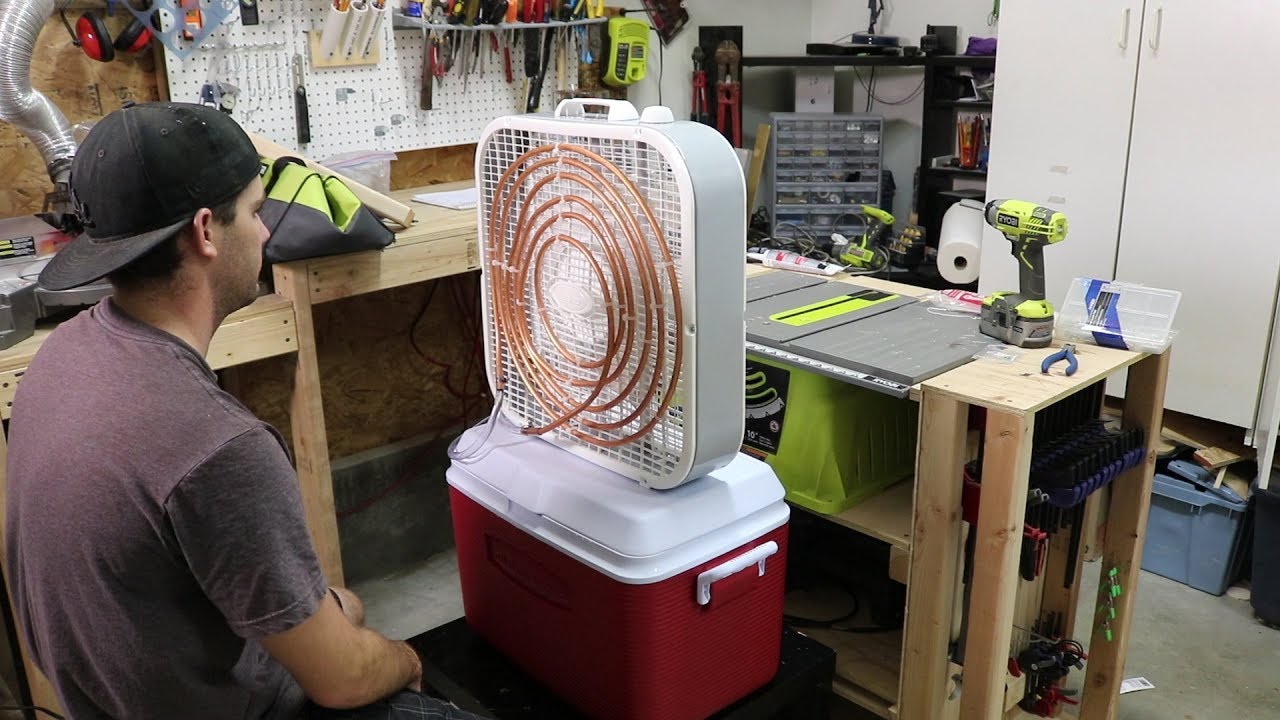When the summer heat hits, it can be unbearable, especially if you don’t have an air conditioner. But guess what? You don’t need to spend a fortune to keep your home cool! With a few simple materials and some creativity, you can create your own air conditioner at home. In this guide, we’ll walk you through the basics of cooling, some nifty DIY approaches, and tips to keep your living space refreshingly cool. Ready to beat the heat? Let’s dive in!
Understanding the Basics of Cooling

Before we get our hands dirty with DIY projects, let’s first grasp the fundamental concepts of how cooling works. Understanding these basics can help you choose the right method for your homemade air conditioner. Here are some key points to consider:
- Heat Transfer: Cooling relies on moving heat from one space to another. The principles of heat transfer—conduction, convection, and radiation—play a significant role here. For example, a fan pushes hot air out while pulling in cooler air.
- Evaporation: One of the most effective natural cooling processes is evaporation. When water evaporates, it absorbs heat, thereby lowering the temperature. DIY air conditioners often utilize this principle with water-soaked materials like towels.
- Humidity Control: High humidity makes heat feel more intense. By reducing humidity levels indoors, cooling becomes more effective. Even simple DIY methods can help with moisture control.
To illustrate how different materials and methods work, here’s a quick table:
| Method | Principle | Effectiveness |
|---|---|---|
| Fan with Ice | Convection | Good for small spaces |
| Evaporative Cooler | Evaporation | Excellent in dry climates |
| Homemade Air Conditioner | Heat Transfer + Evaporation | Variable; depends on design |
By understanding these principles, you'll be better prepared to create your own cooling solution that fits your needs. So, ready to turn up the creativity?
Materials Needed for Your DIY Air Conditioner
Creating your own air conditioner at home is not just a fun DIY project but also an excellent way to beat the heat without breaking the bank. Before you get started, you’ll need to gather a few essential materials. Here's a list of what you’ll need:
- Plastic Storage Bin: This will serve as the main unit of your DIY air conditioner. Choose a size that fits well in the space you plan to use it.
- Fan: A small oscillating fan or a box fan will work best. This is what circulates the cool air.
- Ice Packs or Ice Cubes: Use commercial ice packs or freeze water in plastic containers to provide the cooling element.
- Cooling Tubing (optional): For a more advanced version, you can use PVC pipes or flexible tubing to route the air for a better cooling effect.
- Plastic Wrap: This will seal off areas and ensure that the cold air stays in.
- Drill or Knife: You’ll need this to make holes in the container for the fan and the tubing.
- Thermometer (optional): Keep track of the temperature before and after your DIY AC to measure its effectiveness!
Once you gather these materials, you’ll be well on your way to creating a homemade air conditioning unit that can help you stay cool, especially during those sweltering summer days!
Step-by-Step Guide to Making Your AC
Ready to dive into making your own air conditioner? Follow these simple steps, and you’ll have a DIY cooling solution in no time!
- Prepare the Container: Take your plastic storage bin and place it on a flat surface. Ensure you have enough space around it.
- Cut Holes for the Fan: Using a drill or knife, make a cut-out at one end of the bin that's just big enough for the fan. Make sure the fan fits snugly to minimize airflow escaping out the sides.
- Add Cooling Element: Place your ice packs or ice-filled containers inside the bin. Make sure they are positioned near the fan to maximize cold air circulation.
- Seal Any Open Areas: Use plastic wrap to cover any gaps around the fan and the bin to keep the cold air inside. This step is crucial for efficiency!
- Attach the Fan: Position the fan at the cut-out you made previously and secure it, ensuring that it blows air into the storage bin.
- Turn It On: Plug in the fan, and voilà! You’ve just created your very own air conditioner. Sit back and enjoy the cool breeze!
Keep in mind that this DIY air conditioner is great for personal cooling or small spaces. It’s an eco-friendly option that utilizes ice, so you'll save electricity and money while staying cool!
5. Additional Tips for Improving Efficiency
Creating your own air conditioning system is only half the battle. To truly enjoy the cool air it provides, you need to focus on improving its efficiency. Here are some practical tips to help you maximize your DIY cooling setup:
- Keep Windows and Doors Closed: During the hottest parts of the day, ensure all windows and doors are closed tightly to keep the cool air inside and the hot air outside.
- Use Fans Strategically: Position fans near windows to create cross-ventilation, or direct them to blow cool air around your room. Ceiling fans can also be a useful addition!
- Insulate Your Air Conditioner: If you're using ice or water in your DIY unit, wrap it in insulation materials like towels or blankets to reduce temperature loss.
- Limit Heat Sources: Keep electronics and other heat-generating devices turned off during the hottest times, as they can add unnecessary warmth to your space.
- Cool Your Space at Night: Open windows during the cooler evening hours to allow fresh air to circulate, pre-cooling your home for the next hot day.
By implementing these tips, not only will your DIY air conditioner work better, but you’ll save energy and create a more comfortable environment!
6. Safety Considerations
Safety should always be your top priority, especially when you're dabbling in DIY projects. Here are some essential safety considerations to keep in mind when creating your own air conditioner:
- Electrical Safety: If your cooling system involves electronics, ensure all connections are secure, and avoid using damaged wires. Always unplug devices when making adjustments.
- Water Spillage: If your DIY unit uses water or ice, be cautious of spills that could damage your floors or create slippery hazards.
- Proper Ventilation: If you’re using substances like dry ice or ice packs, ensure your space is well-ventilated to avoid any narrowing air quality issues.
- Fire Hazards: Keep your cooling system away from flammable materials and always monitor the setup to prevent overheating.
- Mold and Mildew: If using water, ensure proper cleaning to avoid stagnation, which can lead to mold growth.
By paying attention to these precautions, you can enjoy your homemade air conditioning setup while keeping your home safe and sound!
How to Create Your Own Air Conditioner at Home with Easy DIY Cooling Tips
With rising temperatures, finding effective and budget-friendly ways to cool down your living space is crucial. You don't need to invest in an expensive air conditioning unit; instead, you can create your own air conditioner at home using simple materials and methods. Here are some DIY cooling tips that can help you beat the heat this summer!
Materials Needed
- Sturdy cardboard box
- Plastic container or rubber tub
- Ice or frozen water bottles
- Fan (box or oscillating fan)
- Scissors or box cutter
- Tape
Step-by-Step Instructions
- Prepare the Box: Cut out a section on one side of the cardboard box, ensuring it's the same size as your fan.
- Insert the Fan: Attach the fan to the cut-out section using tape to secure it in place tightly.
- Fill the Container: Fill your plastic container or rubber tub with ice or frozen water bottles.
- Position the Box: Place the ice-filled container inside the cardboard box, ensuring it's close to the fan.
- Turn on the Fan: Switch on the fan and enjoy the refreshing breeze created by the cold air circulating from the ice!
Additional DIY Cooling Tips
| Tip | Description |
|---|---|
| Use Reflective Materials | Cover windows with aluminum foil or reflective curtains to reduce heat absorption. |
| Seal Drafts | Use weatherstripping or draft stoppers to prevent cool air from escaping your home. |
| Ventilate Effectively | Open windows and doors during cooler evenings to let fresh air in. |
By following these simple instructions and tips, you can create an efficient and cost-effective air conditioning solution for your home. Not only will you stay cool, but you'll also appreciate the satisfaction of creating something with your own hands!
 admin
admin








